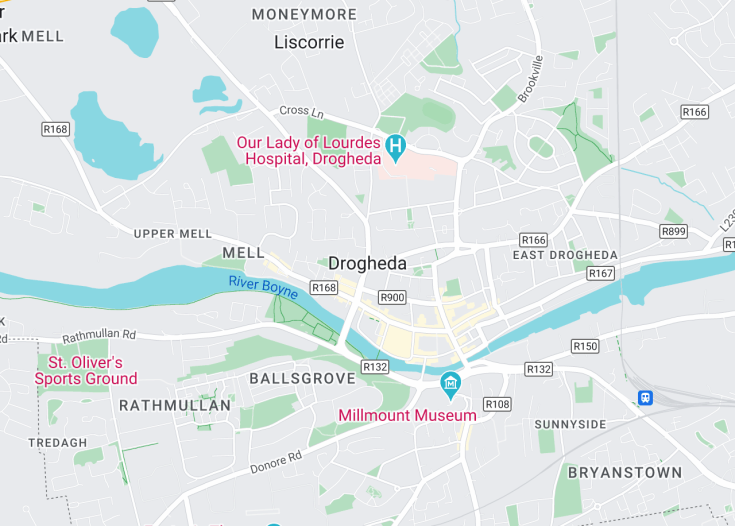Located in Ireland’s historic Boyne Valley, Drogheda is a vibrant town full of charm and rich in heritage. This ancient town, pronounced ‘Draw-ha-duh’, is a perfect blend of historical sites and modern culture. From the famed St. Peter’s Church, housing a shrine to St. Oliver Plunkett, to the Millmount Museum offering panoramic views, Drogheda is a gateway to exploring Ireland’s past and present. The town’s strategic location along the River Boyne adds to its scenic beauty and provides numerous opportunities for leisure and exploration.
For music and arts enthusiasts, plan your visit to coincide with the Drogheda Arts Festival, a vibrant showcase of local and international talent.
Don’t miss a walk along the Boyne River; it’s especially beautiful at sunset and offers a perfect backdrop for memorable photos.
Top things to do & see in Drogheda
Select the following sights and activities to discover best tickets and tours available in Drogheda.
Drogheda: A Tapestry of History and Modernity
| Country | Ireland |
| Time in Drogheda | GMT+1 |
| Language spoken | English |
| Population | 40,956 (2022 Census – Central Statistics Office) |
| Currency | Euro (€, EUR) |
| Airports |
|
Drogheda, sitting along the River Boyne, is one of Ireland’s oldest towns, rich in history and culture. Founded during the Norman invasion of Ireland, Drogheda quickly became an important port. It witnessed significant historical events, like being a key site during the Siege of Drogheda in 1649. Today, Drogheda is a vibrant urban hub, reflecting a blend of historical artifacts and modernity. Its strategic riverside location has fostered not only early settlements and medieval conflict but also thriving contemporary arts and festival scenes. Visitors are drawn to its well-preserved medieval structures like St. Laurence’s Gate, Magdalene Tower, and the historic St. Peter’s Church, home to St. Oliver Plunkett’s shrine.
Where is Drogheda?
Nestled in the northeastern part of Ireland, a few miles inland from the east coast, along the River Boyne.
Distances:
| Route | Distance by car | Time by car |
|---|---|---|
| Dublin to Drogheda | 32 miles (51 km) | 40 minutes |
| Belfast to Drogheda | 70 miles (113 km) | 1 hour 30 minutes |
| Cork to Drogheda | 162 miles (261 km) | 3 hours |
What is Droghedafamous for?
Drogheda is famed for its medieval past and well-preserved heritage sites, including the historic structures like St. Laurence’s Gate and the Millmount Fortress, which offer a glimpse into its turbulent and storied past.
History
Prehistoric Period to Medieval Times
The area now known as Drogheda has a rich history that extends back to the Neolithic period, as evidenced by the nearby presence of the UNESCO World Heritage Site of Newgrange, which dates back to approximately 3200 BC. The town itself was officially founded as two separate towns on either side of the River Boyne in 911 AD by the Norse Vikings. Over the centuries, Drogheda became a key strategic and trading post due to its location by the river and proximity to Dublin.
17th Century: The Siege of Drogheda
One of the most infamous events in Drogheda’s history occurred in 1649 during the Cromwellian conquest of Ireland. The town was besieged by the forces of Oliver Cromwell in September of that year. The siege and subsequent storming of Drogheda led to the massacre of a large proportion of its garrison and civilian population. This event has left a lasting mark on the town’s historical narrative and is commemorated by various monuments and exhibitions in the town.
Industrial Revolution to Modern Times
Drogheda experienced significant development during the Industrial Revolution, becoming a local hub for textile and manufacturing businesses due to its port facilities. In the 20th century, the town continued to expand, assimilating the surrounding area and growing in population. Today, Drogheda is recognized not only for its historical and archaeological significance but also as a vibrant town with a dynamic cultural and arts scene.
Visit Drogheda
Historical and Cultural Exhibitions
Drogheda, a town enriched with centuries of history, offers a plethora of sights for visitors. The town’s historical focal point, St. Laurence’s Gate, originally part of the medieval fortifications, stands majestically in the town center, providing insights into the town’s past defensive strategies. The Highlanes Gallery, housed in a former Franciscan church, showcases contemporary arts alongside periodic historical exhibitions. Another must-visit is the Battle of the Boyne Visitor Centre, which presents engaging displays about this pivotal 1690 battle.
- St. Laurence’s Gate
- Highlanes Gallery
- Battle of the Boyne Visitor Centre
Festive Traditions
Drogheda is vibrant with cultural festivities, notably the Drogheda Arts Festival held annually in late spring. This event brings together a mix of local and international artists in various forms of arts. In August, the town hosts the Boyne Music Festival, celebrating classical, jazz, and traditional music set against the historic backdrop of Townley Hall.
Best time to visit Drogheda
Spring and early summer, from May to June, are ideal for visiting Drogheda. The weather is milder, and the town’s key festivals are underway, providing visitors with a rich blend of cultural exposure and pleasant weather.
Is Drogheda worth visiting?
Drogheda is unquestionably worth visiting for those who cherish history and culture intertwined with the charm of a bustling modern town. Its compelling historical sites, vibrant cultural festivals, and close proximity to significant archaeological sites like Newgrange, make it a unique destination that offers a multifaceted travel experience.









